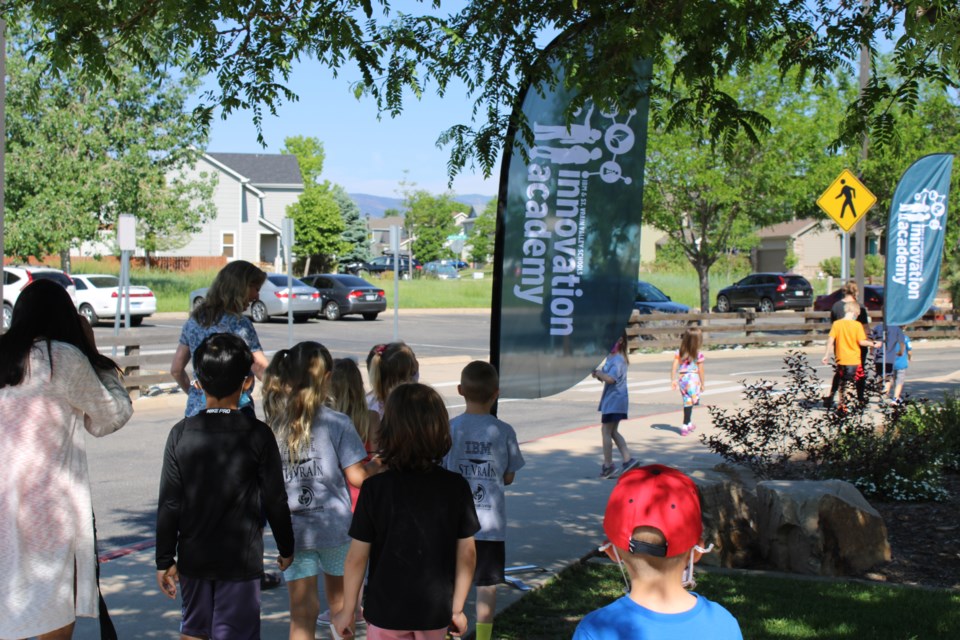Elementary students throughout the St. Vrain Valley School district joined Skyline PTECH students to participate in the district’s 11th Innovation Academy.
The Innovation Academy is a summer program offered to elementary school students grades kindergarten through fifth. The program is in partnership with IBM which sends volunteers to teach students.
The “Innovation Academy fosters a foundation of critical thinking through inquiry-based learning and will create a community of learners that will think globally and collaboratively to develop innovative approaches to problem-solving” according to the district’s website.
Skyline’s PTECH students earn an Associate of Applied Science degree in Computer Information Systems giving them opportunities to intern and receive mentorship from IBM. For the summer these students are hired by camp administrators to help with the Innovation Academy, furthering their engagement with IBM. In addition, these students are able to earn school credits while working at the camp.
The high school students were surprised by the innovation elementary students showed.
“We talk about problems within our groups … and identify problems and how to solve them,” Gabriel, a PTECH student said. After the younger students decide on the problem they wish to solve, the high school students help them think through which materials would be best to solve the problem.
Elementary students are broken up into age groups and allowed to choose from different problem-solving areas. This year the camp offered kindergarteners the opportunity to explore food, first and second grade could choose between school, buildings and transportation and third through fifth grades could choose health, cities, energy or media/communications.
According to Jodi Garner, assistant director of the Innovation Academy, the themes were chosen in collaboration with IBM to promote innovation in areas young children could connect with and come up with solutions.
Kindergarteners spent the first day of camp brainstorming and later building devices that could transport food safely, said Lisa Goebel, Food group supervisor. On the second day, they were taken on a field trip through Blue Mountain Elementary’s cafeteria to complement the day’s lesson on food waste and food insecurity.
In the Building group, Isabella and Oliver were set on building different kinds of structures. Isabella was using pipe cleaners and straws to make a spider web that could hold something heavy, she said.
Oliver was building a structure that could withstand an earthquake. He used plastic straws, aluminum foil and tape to build a column, and later an arch that remained standing even after he shook it forcefully for several minutes.
Students spend the week using the district’s design thinking process to design and prototype ideas within their theme. Each child is allowed to use any of the materials included in the prototyping den to build their idea. The den includes things such as plastic bottle lids, cd cases, cardboard, gears and even tools to help them put their designs together.
“It’s every student’s favorite part of Innovation Academy,” Goebel said.
In the years prior to the pandemic, the Innovation Academy went for two full weeks where students spent an entire week at SVVSD’s Innovation Center and another touring IBM and working with its volunteers. This year, the camp is only one week at Blue Mountain Elementary.
Garner hopes the program can return to two full weeks next summer.
Since IBM could not host students, its volunteers connected via Webex and gave presentations to students and answered questions, Garner said.
Having IBM involved is “empowering to them (the students). They come in as a first or second grader, third, fourth, whatever level they are, and they hear these people speak and think ‘oh, I can work on that,’” Garner said.
Garner also said all the projects worked on at the Innovation Academy begin as a few cardboard boxes taped together, however, with the partnership with IBM students are able to see how their designs translate into physical products that already exist or how their ideas can be used to create such products.
For Garner, seeing the students realize the impact they have on the world around them through their ideas is exciting to watch.
“These are skills that will serve them in real life, regardless of the career path that they choose,” Garner said.



